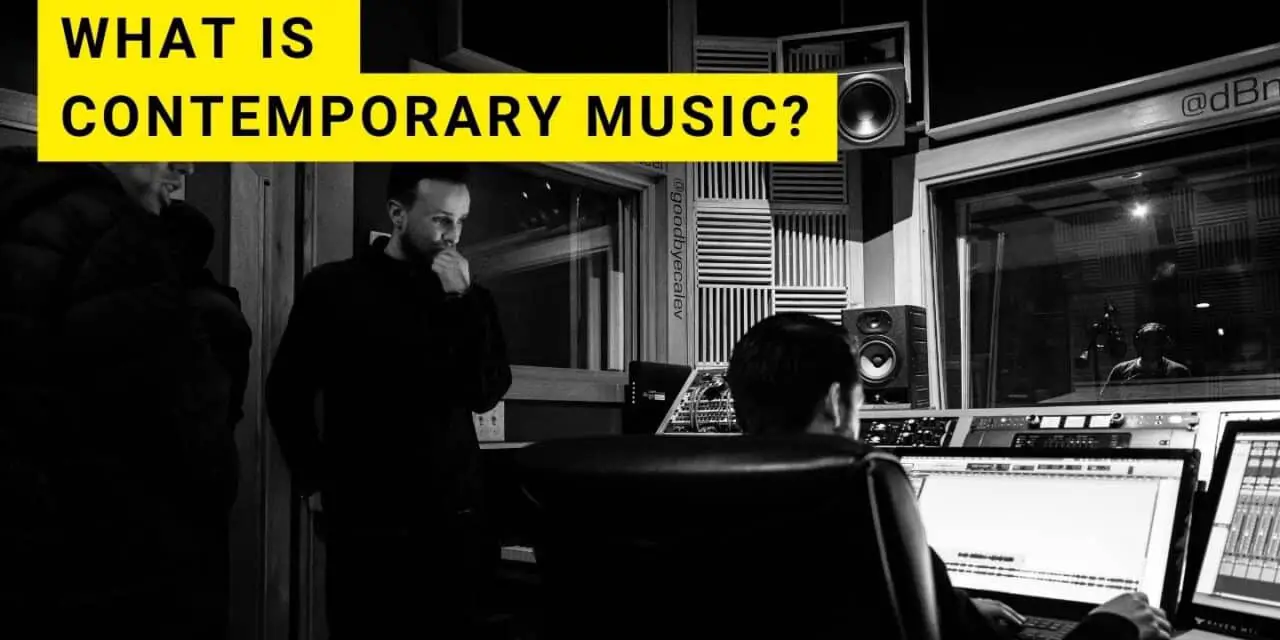Today we’re tuning into the intriguing frequencies of contemporary music.
Often misunderstood or categorized as ‘too complex’ or ‘abstract’, contemporary music is a vast, vibrant landscape waiting to be discovered.
It’s a genre that refuses to be confined by traditional boundaries and constantly seeks to redefine norms and challenge our musical perceptions.
What are the Characteristics of Contemporary Music?
The characteristics of contemporary music usually include many or some of the following:
- Complex Time Signatures
- Electronic & Orchestral Instruments
- Lack of Defined Structure
- Dissonant Harmonies
- Harmonic Chord Progressions
- Pitched Percussion Instruments
Contemporary music is characterized by its diversity of styles and genres, the integration of various musical traditions, use of technology and unconventional sounds, experimentation with structure and form, and a willingness to push boundaries and challenge norms in the pursuit of novel musical expression.
Historical Background of Contemporary Music
To understand the genesis of contemporary music, we have to hop on a time machine and rewind to the early 20th century.
The contemporary music period began its journey during World War II, when composers started experimenting with new forms and structures that veered away from the traditional path.
They wanted to express the complex emotional landscape of a world emerging from devastating conflict and rapid societal change. It was a revolution of sorts, a breaking free from the melodic chains of the past, and the birth of a new musical language.
Different Styles within Contemporary Music
Contemporary music is a broad term encompassing a vast array of music genres and styles that emerged post-1945.
Its versatility and adaptability lend it the richness and dynamism that characterize today’s music scene. Let’s explore various contemporary styles including sub-genres from classical music, to modern music, to dance music.
Art Music
In the world of contemporary art music, we find a great diversity of styles. Composers like Steve Reich and John Cage have pushed the boundaries with minimalism and chance music. There’s also spectral music, a style that emphasizes timbre and texture over harmony and melody. Composers such as Gérard Grisey and Tristan Murail are known for pioneering this genre.
Contemporary Jazz
Contemporary jazz, also referred to as jazz fusion or nu jazz, encapsulates the genre’s evolution in the late 20th and 21st centuries.
This style is considered contemporary music and is marked by a synthesis of jazz harmony and improvisation with other styles such as funk, rock, and world music. Key figures like Miles Davis, Herbie Hancock, and more recently Snarky Puppy and Kamasi Washington, have significantly contributed to the genre. This vibrant offshoot of traditional jazz showcases the genre’s capacity for innovation and cross-genre collaboration, serving as a testament to jazz’s enduring influence in the music world.
Electronic Music
Electronic music has come a long way since Karlheinz Stockhausen and the pioneers of musique concrète began experimenting with synthesized sounds. Today, electronic music spans numerous sub-genres, from ambient to techno to dubstep, each with its unique sound and production techniques. Producers like Aphex Twin, Daft Punk, and Skrillex have left indelible marks on the genre.
Rock Music and Pop Music
Contemporary pop and rock music have also shown significant evolution. Genres like indie rock, pop-punk, and synth-pop have redefined the boundaries of these music styles. Musicians such as Radiohead, Billie Eilish, and Tame Impala exemplify this evolution, introducing innovative elements into their music.
Contemporary Blues Music
Contemporary blues music carries forward the legacy of traditional blues while infusing fresh perspectives and sounds.
The heart of the blues—the evocative, emotive expression of life’s struggles and joys—still beats strong in contemporary blues, but you’ll find expanded stylistic influences, from rock to soul to jazz and beyond. Still, this style of music has its deep roots from African-American folk music.
Artists like Keb’ Mo’, Susan Tedeschi, and Gary Clark Jr. exemplify this genre’s eclectic range. Through their diverse takes on blues conventions, they’ve kept the genre relevant and continually evolving, resonating with new generations of listeners.
Hip-Hop and R&B
Hip-hop and R&B are major pillars of contemporary music. They continue to evolve, integrating elements from other genres and reflecting socio-political issues. Kendrick Lamar’s politically-charged lyrics mixed with hip-hop and Beyoncé’s fusion of R&B with pop and soul are prime examples.
World Music and Fusion Genres
The influence of world music is strongly felt in contemporary music, with genres like reggae, Afrobeat, and salsa gaining worldwide recognition. Simultaneously, fusion genres blend elements from different musical traditions, creating innovative soundscapes. Examples include jazz fusion, Latin rock, and country pop.
Experimental and Avant-Garde
Experimental and avant-garde music push the boundaries of what is considered music. Artists like Laurie Anderson and Yoko Ono challenge conventional song structures, exploring sound in its most raw and unconventional forms.
The spectrum of contemporary music styles is a testament to the genre’s adaptability and innovation. Whether it’s the haunting soundscapes of spectral music or the pulsating rhythms of electronic dance music, contemporary music continues to evolve, reflecting the ever-changing musical landscape.
Contemporary Classical Music
Contemporary classical music, a sub-genre within the wider scope of contemporary music, is a lively and diverse field.
It refers to classical music composed in the late 20th and 21st centuries, exhibiting a vast range of styles and aesthetics.
Composers like Philip Glass with his minimalist approach, Arvo Pärt with his sacred and tintinnabuli styles, and Sofia Gubaidulina with her exploration of unusual instrumental combinations, showcase the genre’s richness. This music often blends traditional orchestral arrangements with novel elements, reflecting the evolving dynamics of classical music in our modern world.
Famous Contemporary Music Composers and Performers
Walking the contemporary music path are several bold composers and performers who’ve defied norms to etch their names in the annals of music history.
Iconic contemporary composers such as John Cage, with his avant-garde and experimental approaches (ever heard a piano played with a cactus?), or Karlheinz Stockhausen, the titan of electronic music, have left indelible marks.
Other performers like Phillip Glass, Michael Buble, the Kronos Quartet, and the Bang on a Can All-Stars bring this innovative music to life, showcasing its energy, beauty, and complexity to audiences worldwide.
Characteristic Elements of Contemporary Music
Unbound by the classical conventions of yesteryears, contemporary music revels in its freedom to explore and experiment. This genre opens up a world of creativity and innovation, infusing fresh life into the music sphere. Let’s delve deeper into the characteristic elements that define contemporary music.
Harmony and Tonality
In contemporary music, conventional tonal harmony takes a back seat, making way for harmonic innovation.
Composers often discard traditional major and minor keys, opting instead for atonal structures where no particular note or key is central. Serialism, an extreme form of atonality, employs a set series of notes as the basis for the entire composition. Simultaneously, minimalism uses simple, repeated harmonies to create a hypnotic effect.
Form and Structure
With its audacious spirit, contemporary music frequently shuns traditional song forms. Instead of standard formats like sonata or rondo, contemporary compositions might use graphic scores, chance operations, or embrace formlessness.
Experimental pieces might even involve audience participation, creating a dynamic, fluid structure that changes with each performance.
Rhythm and Time
Rhythm in contemporary music is often complex, unpredictable, and devoid of a regular pulse. Compositions may explore polyrhythms, using multiple conflicting rhythms at once, or experiment with changing tempos.
Some contemporary works may do away with rhythmic structure altogether, opting for a free-flowing soundscape.
Timbre and Texture
Contemporary music places significant emphasis on timbre and texture, often using these elements to drive the music forward instead of melody or rhythm.
Composers use a range of instruments and sound sources, including electronic sounds and everyday objects, to create a rich tapestry of sonic colors.
Techniques such as extended instrumental techniques, or using instruments in unconventional ways, contribute to this diversity of sound.
Integration of Various Music Styles
Contemporary music is a melting pot of influences. It readily incorporates elements from diverse music styles – jazz, folk, world music, pop, and electronic music, among others. This integration creates a genre-blurring musical landscape, pushing the boundaries of what music can be.
Innovation and Experimentation
At its heart, contemporary music is about pushing boundaries and seeking the new. Composers might experiment with microtonal scales, or use random procedures to determine aspects of the composition.
Innovation also extends to performance techniques, such as prepared piano (where objects are placed on or between the strings to alter the sound) or the use of unconventional sound sources, like environmental sounds or everyday objects.
In essence, contemporary music is an evolving, dynamic genre that defies easy categorization. Its exciting and sometimes challenging features continue to shape the future of music, making it a fascinating field for exploration.
Understanding the Language of Contemporary Music
Contemporary music may seem like a different language, but with a little patience and open-mindedness, it’s possible to decipher its codes.
When listening, let go of the need for a catchy melody or predictable rhythm. Instead, immerse yourself in the sound, the emotion, and the journey it presents.
Listen for the unusual use of instruments, the innovative structures, and the sonic surprises.
By engaging with the music in this way, you’ll begin to understand the dialogue between the composer, the performer, and yourself, the listener. It’s a conversation of discovery, filled with twists and turns, but ultimately rewarding.
The Impact of Technology on Contemporary Music
Technological advances have had a profound impact on contemporary music, unlocking doors to sonic realms previously unimaginable.
Electronic instruments and computer software have transformed the very fabric of music, giving composers unprecedented control over pitch, timbre, and rhythm.
Furthermore, digital platforms have democratized music production, allowing anyone with a computer to compose, produce, and distribute their work. These technological tools have created a breeding ground for innovation, pushing contemporary music to new frontiers.
Contemporary Music’s Influence on Popular Culture
Contemporary music has significantly shaped popular culture, often in subtler ways than we might realize. Its influence permeates various media such as film, television, and video games, where unconventional scores amplify storytelling, setting the mood and heightening emotional impact.
Composers like Hans Zimmer, with his minimalist approach, or Trent Reznor’s and Atticus Ross’ use of electronic soundscapes, owe a debt to contemporary music’s innovative spirit.
Contemporary Music and Education
Contemporary music education serves to equip the next generation of musicians, composers, and listeners with the skills and understanding necessary to navigate this complex and diverse musical landscape.
It embraces a wide array of musical styles and innovative techniques, emphasizing the importance of creativity and personal expression. Let’s delve into the significance of contemporary music in the educational sphere.
Adapting to Modern Musical Landscape
Education in contemporary music offers students the opportunity to engage with the music of their time. It encourages an understanding of diverse musical languages and techniques that are relevant to today’s music scene.
It also helps students develop the ability to adapt to the rapidly changing music industry, fostering skills in composition, improvisation, and performance that extend beyond traditional boundaries.
Developing Critical Thinking and Creativity
Studying contemporary music encourages students to think critically about music and its role in society. By analyzing and engaging with innovative musical works, students cultivate their ability to question, interpret, and critique musical ideas.
Moreover, the freedom and diversity inherent in contemporary music stimulate creativity, encouraging students to develop their unique musical voice.
Berklee and Contemporary Music
When it comes to the marriage of contemporary music and education, Berklee College of Music in Boston stands out.
Berklee, a world-renowned institution, is known for its progressive approach to music education. It offers a wide range of courses in contemporary music, from composition and production to performance and music therapy.
Berklee’s curriculum focuses on creating, performing, and producing music that is relevant to the present music industry.
It provides students with a broad understanding of contemporary music theory and its practical application, fostering creativity and innovation. Berklee alumni include numerous successful contemporary musicians, testifying to the quality and relevance of its music education.
Promoting Cultural Understanding and Diversity
Contemporary music often draws on diverse cultural influences, reflecting the globalized world in which we live.
By studying contemporary music, students gain exposure to a wide array of cultural expressions and musical traditions.
This exposure fosters an appreciation of musical diversity and promotes cultural understanding, crucial traits in our interconnected world.
The importance of contemporary music education goes beyond producing skilled musicians and composers.
It fosters creativity, critical thinking, and cultural understanding, preparing students not only for a career in music but also for an increasingly diverse and complex world.
Criticism and Controversy Surrounding Contemporary Music
Contemporary music, with its experimental ethos, isn’t without controversy. Its departure from conventional musical language has sparked criticism from some quarters, seen as alienating to the average listener.
Questions of musicality and accessibility often arise, with detractors suggesting that contemporary music is too abstract or cerebral.
Yet, its defenders argue that this adventurous spirit is precisely what makes contemporary music vital – it challenges our perceptions, encourages active listening, and opens up new sonic landscapes.
Modern and Contemporary Music
Often, the terms “modern” and “contemporary” are used interchangeably, but when it comes to music, they refer to two distinct periods.
Modern music broadly encompasses the period from the late 19th century to the mid-20th century, a time marked by a drive towards experimentation and innovation. Iconic composers of this era, such as Igor Stravinsky and Arnold Schoenberg, revolutionized music with their daring departures from traditional forms and structures.
In contrast, contemporary music refers to works composed post-1945, reaching into the present day. This period reflects an even greater expansion of musical styles and techniques, from minimalism to electronic music to cross-genre fusions (and even including pop music).
Artists have the freedom to blend musical traditions, incorporate non-musical sounds, and explore new technologies in their compositions.
While the labels ‘modern’ and ‘contemporary’ can overlap in casual conversation, they represent specific, transformative periods in music history when distinguished. In their own unique ways, both periods continue to shape the exciting and diverse soundscape of music we enjoy today.
The Future of Contemporary Music
Gazing into the crystal ball, it’s tricky to predict exactly where contemporary music will head next – and that’s part of its excitement! With its inherent adaptability, it’s poised to continue pushing boundaries and questioning musical norms. Advances in technology, evolving societal contexts, and new artistic visions will undoubtedly shape its future direction. One thing’s for certain: contemporary music will continue to redefine what music can be, acting as a thrilling playground for sonic exploration and discovery.






